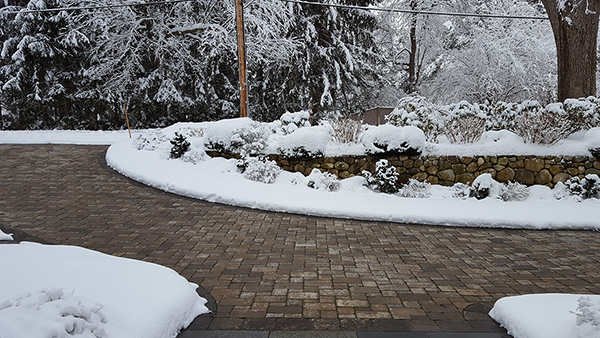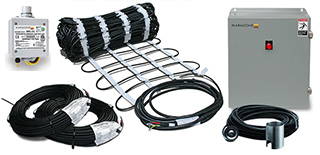Heated Driveways for Fort Wayne and Indiana
| FORT WAYNE WEATHER FACTS AND STATS |
| Fort Wayne's coldest month is January when the average temperature overnight is 24.5°F. |
| Average annual snowfall is 34 inches. |
| Heaviest snowfall: 61.1 inches in winter of 1981-1982. |
| Average daily high temperature December thru March is 38 degrees Fahrenheit. |
| The annual high temperature is 60.1°F. |
| The annual low temperature is 40.6°F. |
| January is the snowiest month of the year, averaging 10 inches. |
For over a decade Warmzone has been providing industry leading snow melting systems for heating driveways, sidewalks, steps, and more. The versatile ClearZone electric snow melting systems are easy to customize and can be installed to heat concrete, asphalt and pavers in a number of applications.
Many home and business owners in the Fort Wayne area are turning to radiant heat to keep driveways, sidewalks and parking areas clear of snow and ice. Business owners are particularly fond of radiant snow melting systems because of their reliable, automated performance. Keeping sidewalks and entryways clear of snow is a crucial safety benefit that greatly reduces slip-and-fall accidents. And as many business owners will attest, any opportunity to enhance customer safety and minimize personal injury cases should be strongly considered.
How Snow Melting Systems Work
Heated driveways and snow melting systems rely on electric heating cable, a snow sensor (activation device), and a control panel or controller. The heat cable is embedded in the concrete or asphalt (or under pavers) and connected to the control panel. For residential applications, the control panel is generally mounted on a wall in the garage.
 The snow sensor can either be an aerial-mount sensor or a ground-mount sensor. The aerial-mount sensor is
typically installed just above the roofline where it has clear access to the elements. The pavement-mount
sensor is usually placed in the driveway or area that is being heated. These activation devices detect
precipitation and temperature, so if precipitation is detected and the temperature is below the set point
(usually 39°F), the sensor signals the control panel. The panel then sends power to the embedded cable to
heat the driveway, sidewalk or parking area. The power warms the cable, preventing any snow from accumulating.
The system remains on for a short time after the storm to dry the driveway, thereby preventing a thin sheet of
ice from forming.
The snow sensor can either be an aerial-mount sensor or a ground-mount sensor. The aerial-mount sensor is
typically installed just above the roofline where it has clear access to the elements. The pavement-mount
sensor is usually placed in the driveway or area that is being heated. These activation devices detect
precipitation and temperature, so if precipitation is detected and the temperature is below the set point
(usually 39°F), the sensor signals the control panel. The panel then sends power to the embedded cable to
heat the driveway, sidewalk or parking area. The power warms the cable, preventing any snow from accumulating.
The system remains on for a short time after the storm to dry the driveway, thereby preventing a thin sheet of
ice from forming.
Automated snow melting systems keep areas clear of snow and ice 24/7. Business owners can relax, knowing that the system is keeping the walks safe for customers and employees alike.
Heat cable from Warmzone is available off the spool or pre-spaced in easy-to-roll-out mats. The cable is pre-spaced according to the specifications of the project and simplifies the installation process. ClearZone heat cable has proven itself to be one of today’s leading radiant heat cables.
 Also, electric snow melting systems are easy to customize to not only meet customers’ snow melting demands
but also their budget. The variety of configurations is virtually unlimited. Small, odd shaped areas can be
heated, or two 24-inch wide heated tire tracks can be installed. The options are limitless. Call and talk to
a radiant heat expert today at 888.488.9276 to learn more about your options.
Also, electric snow melting systems are easy to customize to not only meet customers’ snow melting demands
but also their budget. The variety of configurations is virtually unlimited. Small, odd shaped areas can be
heated, or two 24-inch wide heated tire tracks can be installed. The options are limitless. Call and talk to
a radiant heat expert today at 888.488.9276 to learn more about your options.
Warmzone also provides complete system design and layout services, free installation training and installation support. And since we’ve worked with installers in the Indiana area before, we can recommend those who are experienced with installing radiant heat. We’re proud to not only offer the industry’s premier products, but the industry’s finest customer services as well.
Make it easy on yourself and keep your driveway clear with radiant heat. That way instead of spending an hour shoveling snow on Saturday morning, you can grab the kids and dash up to the toboggan run at Pokagon State Park instead.
